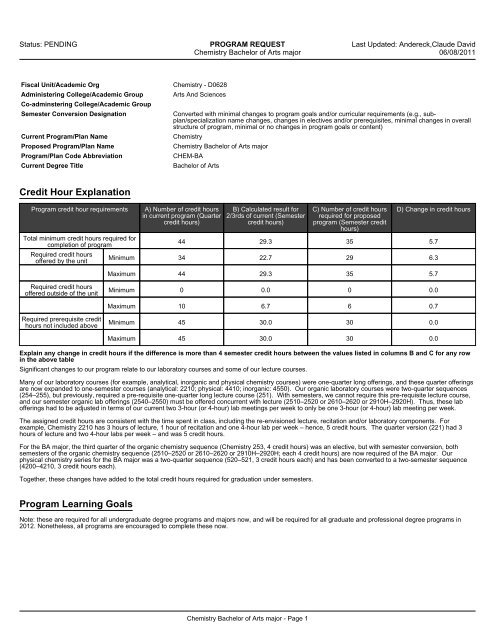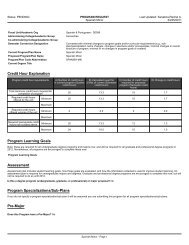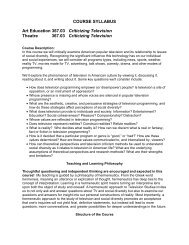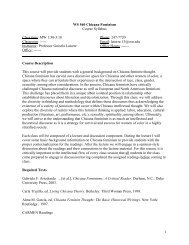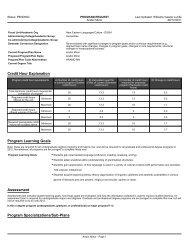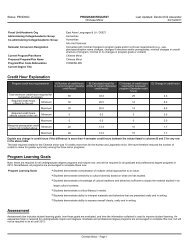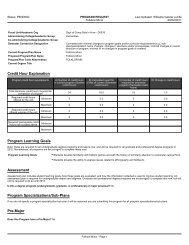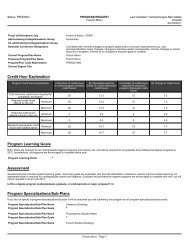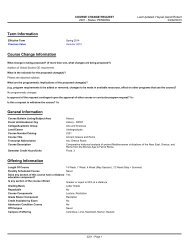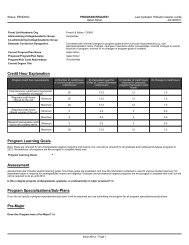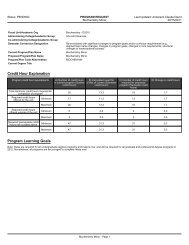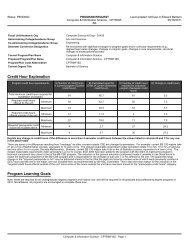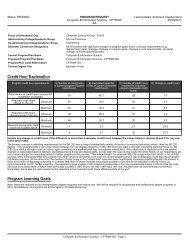Chemistry BA Revised 6-8-11.pdf - The Ohio State University
Chemistry BA Revised 6-8-11.pdf - The Ohio State University
Chemistry BA Revised 6-8-11.pdf - The Ohio State University
Create successful ePaper yourself
Turn your PDF publications into a flip-book with our unique Google optimized e-Paper software.
Status: PENDINGPROGRAM REQUEST<strong>Chemistry</strong> Bachelor of Arts majorLast Updated: Andereck,Claude David06/08/2011Fiscal Unit/Academic OrgAdministering College/Academic GroupCo-adminstering College/Academic GroupSemester Conversion DesignationCurrent Program/Plan NameProposed Program/Plan NameProgram/Plan Code AbbreviationCurrent Degree Title<strong>Chemistry</strong> - D0628Arts And SciencesConverted with minimal changes to program goals and/or curricular requirements (e.g., subplan/specializationname changes, changes in electives and/or prerequisites, minimal changes in overallstructure of program, minimal or no changes in program goals or content)<strong>Chemistry</strong><strong>Chemistry</strong> Bachelor of Arts majorCHEM-<strong>BA</strong>Bachelor of ArtsCredit Hour ExplanationProgram credit hour requirementsTotal minimum credit hours required forcompletion of programRequired credit hoursoffered by the unitA) Number of credit hoursin current program (Quartercredit hours)B) Calculated result for2/3rds of current (Semestercredit hours)C) Number of credit hoursrequired for proposedprogram (Semester credithours)D) Change in credit hours44 29.3 35 5.7Minimum 34 22.7 29 6.3Maximum 44 29.3 35 5.7Required credit hoursoffered outside of the unitMinimum 0 0.0 0 0.0Maximum 10 6.7 6 0.7Required prerequisite credithours not included aboveMinimum 45 30.0 30 0.0Maximum 45 30.0 30 0.0Explain any change in credit hours if the difference is more than 4 semester credit hours between the values listed in columns B and C for any rowin the above tableSignificant changes to our program relate to our laboratory courses and some of our lecture courses.Many of our laboratory courses (for example, analytical, inorganic and physical chemistry courses) were one-quarter long offerings, and these quarter offeringsare now expanded to one-semester courses (analytical: 2210; physical: 4410; inorganic: 4550). Our organic laboratory courses were two-quarter sequences(254–255), but previously, required a pre-requisite one-quarter long lecture course (251). With semesters, we cannot require this pre-requisite lecture course,and our semester organic lab offerings (2540–2550) must be offered concurrent with lecture (2510–2520 or 2610–2620 or 2910H–2920H). Thus, these labofferings had to be adjusted in terms of our current two 3-hour (or 4-hour) lab meetings per week to only be one 3-hour (or 4-hour) lab meeting per week.<strong>The</strong> assigned credit hours are consistent with the time spent in class, including the re-envisioned lecture, recitation and/or laboratory components. Forexample, <strong>Chemistry</strong> 2210 has 3 hours of lecture, 1 hour of recitation and one 4-hour lab per week – hence, 5 credit hours. <strong>The</strong> quarter version (221) had 3hours of lecture and two 4-hour labs per week – and was 5 credit hours.For the <strong>BA</strong> major, the third quarter of the organic chemistry sequence (<strong>Chemistry</strong> 253, 4 credit hours) was an elective, but with semester conversion, bothsemesters of the organic chemistry sequence (2510–2520 or 2610–2620 or 2910H–2920H; each 4 credit hours) are now required of the <strong>BA</strong> major. Ourphysical chemistry series for the <strong>BA</strong> major was a two-quarter sequence (520–521, 3 credit hours each) and has been converted to a two-semester sequence(4200–4210, 3 credit hours each).Together, these changes have added to the total credit hours required for graduation under semesters.Program Learning GoalsNote: these are required for all undergraduate degree programs and majors now, and will be required for all graduate and professional degree programs in2012. Nonetheless, all programs are encouraged to complete these now.<strong>Chemistry</strong> Bachelor of Arts major - Page 1
Status: PENDINGPROGRAM REQUEST<strong>Chemistry</strong> Bachelor of Arts majorLast Updated: Andereck,Claude David06/08/2011Program Learning Goals• 1. Students solve state-of-the-art chemistry problems, working both individually and in groups, and these problemswill exemplify current disciplinary and interdisciplinary principles as well as modern pedagogical practice.• 2. Students develop effective skills in oral and written communication of scientific knowledge.•3. Students plan experimental procedures, carry out chemical procedures, use laboratory equipment, analyze dataand prepare laboratory reports that reinforce current chemical practices.• 4. Students follow safe practices in the laboratory and demonstrate scientifically ethical practices.• 5. Students retrieve information from the chemical literature, and become proficient in online database searching.• 6. Students use modern computer software for graphing, manipulation of symbolic mathematical expressions, andquantum chemical calculations.AssessmentAssessment plan includes student learning goals, how those goals are evaluated, and how the information collected is used to improve student learning. Anassessment plan is required for undergraduate majors and degrees. Graduate and professional degree programs are encouraged to complete this now, but willnot be required to do so until 2012.Is this a degree program (undergraduate, graduate, or professional) or major proposal? YesDoes the degree program or major have an assessment plan on file with the university Office of Academic Affairs? YesSummarize how the program's current quarter-based assessment practices will be modified, if necessary, to fit the semester calendar.No modifications are planned or required to fit the semester calendar.Program Specializations/Sub-PlansIf you do not specify a program specialization/sub-plan it will be assumed you are submitting this program for all program specializations/sub-plans.Pre-MajorDoes this Program have a Pre-Major? NoAttachments• <strong>Chemistry</strong> <strong>BA</strong> cover letter.doc: NMS Division of Arts and Sciences cover letter(Letter from the College to OAA. Owner: Andereck,Claude David)•CCI Subcommittee Chair Letter--<strong>Chemistry</strong><strong>BA</strong> CCI.doc: CCI Subcommittee Chair Letter(Other Supporting Documentation. Owner: Vankeerbergen,Bernadette Chantal)•<strong>Chemistry</strong>_<strong>BA</strong>_major_v5.pdf: <strong>Revised</strong> <strong>Chemistry</strong> <strong>BA</strong> proposal(Program Proposal. Owner: Hadad,Christopher Martin)•<strong>Chemistry</strong>_<strong>BA</strong>_major_v5_comments.pdf: Comments on program revision(Other Supporting Documentation. Owner: Hadad,Christopher Martin)Comments<strong>Chemistry</strong> Bachelor of Arts major - Page 2
Status: PENDINGPROGRAM REQUEST<strong>Chemistry</strong> Bachelor of Arts majorLast Updated: Andereck,Claude David06/08/2011Workflow InformationStatus User(s) Date/Time StepSubmittedApprovedHadad,ChristopherMartinHadad,ChristopherMartin03/30/2011 06:53 PM Submitted for Approval03/30/2011 06:53 PM Unit ApprovalRevision Requested Andereck,Claude David 03/31/2011 12:12 PM College ApprovalSubmittedApprovedHadad,ChristopherMartinHadad,ChristopherMartin03/31/2011 11:25 PM Submitted for Approval03/31/2011 11:27 PM Unit ApprovalRevision Requested Andereck,Claude David 04/05/2011 01:17 PM College ApprovalSubmittedApprovedHadad,ChristopherMartinHadad,ChristopherMartin04/11/2011 02:22 PM Submitted for Approval04/11/2011 02:23 PM Unit ApprovalRevision Requested Andereck,Claude David 04/14/2011 10:32 AM College ApprovalSubmittedApprovedHadad,ChristopherMartinHadad,ChristopherMartin04/16/2011 03:02 PM Submitted for Approval04/16/2011 03:03 PM Unit ApprovalApproved Andereck,Claude David 04/19/2011 11:40 AM College ApprovalRevision RequestedSubmittedApprovedVankeerbergen,Bernadette ChantalHadad,ChristopherMartinHadad,ChristopherMartin04/29/2011 03:32 PM ASCCAO Approval06/07/2011 05:14 PM Submitted for Approval06/07/2011 05:15 PM Unit ApprovalApproved Andereck,Claude David 06/08/2011 08:03 AM College ApprovalPending ApprovalNolen,DawnJenkins,Mary Ellen BiglerMeyers,Catherine AnneVankeerbergen,Bernadette ChantalHanlin,Deborah Kay06/08/2011 08:03 AM ASCCAO Approval<strong>Chemistry</strong> Bachelor of Arts major - Page 3
To: Larry Krissek, Chair, Committee on Curriculum and Instruction(CCI)From: James Fredal, Chair, CCI Sciences SubcommitteeRe: <strong>Chemistry</strong> <strong>BA</strong> Degree Semester Conversion ProposalDate: April 26, 2011Larry:<strong>The</strong> Sciences subcommittee of the CCI met on Monday, April 25 to review the <strong>BA</strong> degreeprogram in <strong>Chemistry</strong> and approved the proposal unanimously contingent upon the followingchanges and corrections.<strong>The</strong> PACER chart indicates a marked rise in total credit hours to degree. This rise is explained,but the explanation was unsatisfactory and needs clarification since it appears that some courses,and lab courses in particular, are undergoing a marked increase in contact hours from quarters tosemesters. Part of the problem seems to be the straight conversion of individual courses (ratherthan sequences) from quarters to semesters with the same number of credit hours. <strong>The</strong> suggestionwas made that if the second advanced science elective were dropped, some of the increase in totalhours would be eliminated.Several recommendations duplicate those for the BS proposal: many of the courses are not listedwith their quarter equivalent on the course list; the semester advising sheet is not clear about thetotal core hours, elective hours, and prerequisite hours; the four-year plans should be moved to thebottom of the document; and the transition plan should spell out more clearly the plans for bridgecourses.As with the BS, we felt these corrections and requests were insufficient reason to send thedocument back, so we forward it with a recommendation for approval and with the understandingthat these matters will be addressed before it leaves the CCI.Thanks very much,Jim Fredalcc: Bernadette Vankeerbergen
College of Arts and Sciences______________________________________________________________________________________________186 <strong>University</strong> Hall230 North Oval MallColumbus, OH 43210Phone (614) 292-8908Fax (614) 247-7498April 19, 2011Larry KrissekChair, Arts and Sciences CCIDear Larry:It is a pleasure to forward to you the proposal for the Bachelor of Arts in <strong>Chemistry</strong> under semesters. <strong>The</strong>program has been converted with minimal revision. <strong>The</strong>re have been changes to the laboratory courses, themost important being to allow students to take the organic chemistry laboratories concurrently with the lectures.A second important change has been to offer a version of organic chemistry for majors, in addition to thestandard and honors versions—this had already occurred for the introductory sequence.Beyond my own review of the documents, the proposal has been discussed by colleagues from other NMS unitsat a meeting on April 5, 2011. Feedback from these discussions has been incorporated in the proposal.If you have any questions, I would be happy to address them.Sincerely,David AndereckProfessor of PhysicsAssociate Dean of Natural and Mathematical Sciences, College of Arts and Sciences
Department of <strong>Chemistry</strong>Newman and Wolfrom Laboratory100 West 18 th AvenueColumbus, OH 43210-1185www.chemistry.ohio-state.eduJune 7, 2011To:Re:<strong>University</strong> Semester Conversion CommitteesConversion of Undergraduate Major (B.A. and B.S.) and Minor Programs in <strong>Chemistry</strong><strong>The</strong> Department of <strong>Chemistry</strong> currently offers a Bachelor of Arts (<strong>BA</strong>) and a Bachelor ofScience (BS) degree as part of our majors program, along with a minor in <strong>Chemistry</strong>. Ourcurrently offered majors programs prepare students for a variety of careers, with the <strong>BA</strong> degreebeing less intensive in required chemistry courses, thereby offering opportunities forundergraduate students to expand their schedules with interdisciplinary courses. Historically,our <strong>BA</strong> degree has been the most popular with students who are intending to pursue preprofessionalprograms (pre-medicine, pre-dental, pre-veterinary, pre-pharmacy, pre-optometry,pre-law, etc) or for chemistry-related employment, including sales and marketing. <strong>The</strong> BSdegree requires more chemistry and mathematics courses and is better preparation for a studentgoing off to graduate school in a chemically related discipline (chemistry, biochemistry,pharmacy, etc) or for employment in chemistry (pharmaceutical or materials chemistry). Whilethere is some variation from year to year, there are about 450 chemistry majors across all ranksin 2011, and approximately 50% of them are intending on the <strong>BA</strong> degree while 50% are workingtowards the BS degree.<strong>The</strong> American Chemical Society (ACS: www.acs.org) provides guidelines for the educationalpreparation for degrees in <strong>Chemistry</strong>, and the department is currently certified to comply withthose guidelines. For some institutions, there are significant guidelines as to contact hours byinstructors and so on; however, for a large university like <strong>Ohio</strong> <strong>State</strong>, the most important aspectsof the guidelines are a minimum amount of hours (400) in the chemistry laboratory across theentire program (but excluding first-year general chemistry), a minimum exposure to laboratoryexperience in 4 of the 5 major areas of chemistry (analytical, biological, inorganic, organic andphysical) as well as lecture instruction in all 5 areas.On a yearly basis, the department provides an update report to the ACS as to our current programand its requirements, and on a 5-year schedule, we re-apply for re-certification of our majorprograms. Thus, upon graduation, our BS majors can receive a certified ACS degree if theycomply with the ACS requirements. Between 25 – 50% of our BS majors per year receive ACScertified degrees.3
Our program continues to grow, with approximately 200% more chemistry majors as new firstquarter freshmen (NFQFs) in autumn 2010 as compared to a typical number of 35–40 incomingstudents in the 1990s.<strong>The</strong> process for the conversion of our undergraduate major and minor programs began insummer 2010 with many discussions with our faculty and teaching staff. <strong>The</strong> courses werediscussed at numerous meetings of the faculty at large as well as the Undergraduate CurriculumCommittee, chaired by the Vice Chair for Undergraduate Studies (Christopher Hadad). OnDecember 10, 2010, the Undergraduate Curriculum Committee unanimously voted to adopt theenvisioned programs presented here for the revised undergraduate programs under semesters.<strong>The</strong>n, the faculty voted on the same programs at a January 19, 2011 faculty meeting and voted25 in favor, 0 against and 0 abstain to adopt these revisions to our programs.<strong>The</strong> details of these revised programs are provided in the accompanying documentation.If you have any questions, please contact Christopher Hadad at (614) 292–1204 orhadad.1@osu.edu.Sincerely,Malcolm H. ChisholmChair and Distinguished <strong>University</strong> ProfessorDepartment of <strong>Chemistry</strong>Christopher M. HadadVice Chair for Undergraduate StudiesDepartment of <strong>Chemistry</strong>4
Program Rationale <strong>State</strong>ment (Bachelor of Arts degree in <strong>Chemistry</strong>)<strong>The</strong> revised program for the Bachelor of Arts (<strong>BA</strong>) degree in <strong>Chemistry</strong> is a relativelystraightforward conversion of our existing <strong>BA</strong> degree under quarters. Our learning goals andoutcomes have been abbreviated in terms of language as compared to the current assessment plan;however, the goals are relatively invariant.Approximately half of our current majors are working towards the <strong>BA</strong> degree. We maintain coreexperiences in general, analytical, organic, and physical chemistry. Inorganic chemistry andbiochemistry are elective courses. Exposure to biochemistry is strongly encouraged and wouldfulfill an advanced science elective, as would research experience. Advanced science electives canbe fulfilled by pre-professional students who require specific courses in molecular genetics orbiochemistry. Relative to our <strong>BA</strong> degree under quarters, we continue to require similar content inmathematics (through calculus, Math 1152) and a year of physics (1200–1201).<strong>The</strong> most significant changes to our program relate to our laboratory courses. Many of ourlaboratory courses (for example, analytical, inorganic and physical chemistry courses) were onequarterlong offerings, and these quarter offerings are now expanded to one-semester courses(analytical: 2210; physical: 4410). Our organic laboratory courses were two-quarter sequences(254–255), but previously, required a pre-requisite one-quarter long lecture course (251). Withsemesters, we cannot require this pre-requisite lecture course, and our semester organic labofferings (2540–2550) must be offered concurrent with lecture (2510–2520 or 2610–2620 or2910H–2920H). Thus, these lab offerings had to be adjusted in terms of our current two 3-hour(or 4-hour) lab meetings per week to only be one 3-hour (or 4-hour) lab meeting per week.For the <strong>BA</strong> major, the third quarter of the organic chemistry sequence (<strong>Chemistry</strong> 253, 4 credithours) was an elective, but with semester conversion, both semesters of the organic chemistrysequence (2510–2520 or 2610–2620 or 2910H–2920H; each 4 credit hours) are now required ofthe <strong>BA</strong> major. Our physical chemistry series for the <strong>BA</strong> major was a two-quarter sequence (520–521, 3 credit hours each) and has been converted to a two-semester sequence (4200–4210, 3 credithours each). Together, these changes have added to the total credit hours required for graduationunder semesters.Overall, our new semester plan is commensurate with semester offerings by peer institutions.Relative to the BS degree, the <strong>BA</strong> chemistry major would have less mathematics and the noncalculusversion of physics as required courses. As with our quarter curriculum, the calculusversion of physics is an option.Another change is an extension of our current effort to have a majors-only version of our highenrollmentcourses. Until only recently, our <strong>Chemistry</strong> majors have been able to take our Honorssequence (201H–202H–203H) or the regular sequence (121–122–123) of general chemistry. In2009, we created a new general chemistry sequence for chemistry (and biochemistry) majors:161–162–163. <strong>The</strong>se options have been maintained for general chemistry under semesters (honors,majors-only, and regular sequences). Organic chemistry has been a similar challenge with our100+ chemistry majors immersed in a sea of 1500+ (predominantly pre-professional) students.While Honors organic chemistry was an option, there was no majors-only version of organic5
chemistry. For semesters, we have created a 2610–2620 organic sequence for chemistry (andbiochemistry) majors, along with retention of our honors (2910H–2920H) and regular (2510–2520) sequences. We anticipate that content of pertinent relevance to chemistry (andbiochemistry) majors will be provided in the majors-only sequence (for example, state-of-the-artmethodologies in carbon-carbon bond-forming reactions as well as asymmetric or catalyticprocesses).We do not have specializations or subprograms for our <strong>BA</strong> degree; instead, from one-on-onediscussions between the undergraduate student and our chemistry advisors, we create the idealprogram of courses that will cater to the specific interests of the student. For example, a chemistrymajor who plans to attend medical school would be advised to take some additional courses inmolecular genetics and biochemistry prior to graduation. Those courses would count as advancedscience electives in the junior and senior years.Research remains a highly recommended and encouraged science elective.With regard to the four-year plan, the Bachelor of Arts curriculum is intended for students whowant to have a background in chemistry as a basis for future work in other areas of science, suchas the life sciences, or in such professional areas as medicine or veterinary medicine. <strong>Chemistry</strong>1610 – 1620 is the recommended general chemistry sequence for chemistry majors who presenthigh school chemistry for entrance, although qualified students are strongly urged to take thehonors general chemistry sequence, <strong>Chemistry</strong> 1910H – 1920H, instead. (<strong>Chemistry</strong> 1210 – 1220are acceptable, but are not the preferred sequence for chemistry majors.)Organic <strong>Chemistry</strong> and Quantitative Analysis 2210 (or 2210H) are taken in the second year. Aswith general chemistry, <strong>Chemistry</strong> 2610 – 2620 is the recommended organic chemistry lecturesequence for chemistry majors, although qualified students are strongly urged to take the honorssequence, <strong>Chemistry</strong> 2910H – 2920H, instead. (<strong>Chemistry</strong> 2510 – 2520 are acceptable, but are notthe preferred organic lecture sequence for chemistry majors.) <strong>The</strong> Organic <strong>Chemistry</strong> labexperience is either the 2540 – 2550 sequence or the honors version (2940H – 2950H).Physical <strong>Chemistry</strong> 4200 – 4210 and Physical <strong>Chemistry</strong> Laboratory 4410 are required; <strong>Chemistry</strong>4300 – 4310 may be taken instead of 4200 – 4210 with the proper math prerequisite. <strong>The</strong> major iscompleted by 9 credit hours of advanced science electives that must include at least 3 credit hoursof chemistry courses. Advanced science electives must be approved by the undergraduatechemistry advisors. Examples of science electives include: any un-required, graded 4000 – 6000level courses in <strong>Chemistry</strong>; 4000 or 5000 level courses in Astronomy, Biochemistry, PlantBiology, Molecular Genetics, Earth Sciences, Microbiology, Physics, and EEOB; and mostcourses in Mathematics at the 2000 – 4000 level. Not more than six hours of undergraduateresearch (<strong>Chemistry</strong> 4998/4999, or honors versions) may be used to fulfill the science electiverequirement.While we show a typical sequence of courses, we will offer many of these course offerings in boththe autumn and spring quarters so that students can adjust their schedules for their particularneeds. We anticipate that an undergraduate student who starts with general chemistry in their firstyear will have little difficulty to graduate in 4 years.6
<strong>The</strong> Bachelor of Arts Degree in <strong>Chemistry</strong> (B.A.)<strong>The</strong> Bachelor of Arts curriculum is intended for students who want to have a background in chemistry as a basis for futurework in other areas of science, such as the life sciences, or in such professional areas as medicine or veterinary medicine.<strong>Chemistry</strong> 1610 – 1620 is the recommended general chemistry sequence for chemistry majors who present high schoolchemistry for entrance, although qualified students are strongly urged to take the honors general chemistry sequence,<strong>Chemistry</strong> 1910H – 1920H, instead. (<strong>Chemistry</strong> 1210 – 1220 are acceptable, but are not the preferred sequence forchemistry majors.) Organic <strong>Chemistry</strong> and Quantitative Analysis 2210 (or 2210H) are taken in the second year. As withgeneral chemistry, <strong>Chemistry</strong> 2610 – 2620 is the recommended organic chemistry lecture sequence for chemistry majors,although qualified students are strongly urged to take the honors sequence, <strong>Chemistry</strong> 2910H – 2920H, instead. (<strong>Chemistry</strong>2510 – 2520 are acceptable, but are not the preferred organic lecture sequence for chemistry majors.) <strong>The</strong> Organic<strong>Chemistry</strong> lab experience is either the 2540 – 2550 sequence or the honors version (2940H – 2950H). Physical <strong>Chemistry</strong>4200 – 4210 and Physical <strong>Chemistry</strong> Laboratory 4410 are required; <strong>Chemistry</strong> 4300 – 4310 may be taken instead of 4200 –4210 with the proper math prerequisite. <strong>The</strong> major is completed by 9 credit hours of advanced science electives whichmust include at least 3 credit hours of chemistry courses. Advanced science electives must be approved by theundergraduate chemistry advisors. Examples of science electives include: any un-required, graded 4000 – 6000 levelcourses in <strong>Chemistry</strong>; 4000 or 5000 level courses in Astronomy, Biochemistry, Plant Biology, Molecular Genetics, EarthSciences, Microbiology, Physics, and EEOB; and most courses in Mathematics at the 2000 – 4000 level. Not more than sixhours of undergraduate research (<strong>Chemistry</strong> 4998/4999, or honors versions) may be used to fulfill the science electiverequirement. A sample curriculum for semesters is given below. Your advisors will work with you to design your idealcurriculum. Check with your chemistry advisor to design a schedule for your chemistry, math, physics, and other sciencecourses.Autumn Semester (Year 1) Spring Semester (Year 1)General <strong>Chemistry</strong> 1 (1910H, 1610, 1210) 5 General <strong>Chemistry</strong> 2 (1920H, 1620, 1220) 5Calculus 1 (Math 1151) 5 Calculus 2 (Math 1152) 5GE Elective (e.g. biological sciences) 4 GE Elective 3GE Elective 3 GE Elective 3Survey 118 16Autumn Semester (Year 2) Spring Semester (Year 2)Analytical <strong>Chemistry</strong> 1 (2210H, 2210) 5 Organic <strong>Chemistry</strong> 2 (2920H, 2620, 2520) 4Organic <strong>Chemistry</strong> 1 (2910H, 2610, 2510) 4 Organic <strong>Chemistry</strong> Laboratory 2 (2950H, 2550) 2Organic <strong>Chemistry</strong> Laboratory 1 (2940H, 2540) 2 Introductory Physics II (1201 or 1251) 5Introductory Physics I (1200 or 1250) 5 GE Elective 316 14Autumn Semester (Year 3) Spring Semester (Year 3)Physical <strong>Chemistry</strong> 1 (4200) 3 Physical <strong>Chemistry</strong> 2 (4210) 3Advanced <strong>Chemistry</strong> Elective 3 Physical <strong>Chemistry</strong> Laboratory (4410) 3Elective 3 Elective 3GE Elective 4 GE Elective 3GE Elective 413 16Autumn Semester (Year 4) Spring Semester (Year 4)Advanced Science Elective (e.g. Biochem 4511 a ) 3 Advanced Science Elective 3Elective 3 Elective 3Elective 3 GE Elective 3GE Elective 4 GE Elective 3GE Elective 313 15a Biochemistry 4511 = 4 credit hours7
MAJOR PROGRAM FORMCollege of the Arts and SciencesDepartment of<strong>Chemistry</strong> Student:_________________________________________________________ Major:___________________________<strong>Chemistry</strong> – B.A. Last First MiddleStudent No.:____________________________ Degree Sought:_____________ B.A. Advisor:_________________________Name.#:______________________________________ Expected Semester and Year of Graduation:_______________Courses Hours Semester TakenChem 2210 or 2210H 5Chem 2510 or 2610 or 2910H 4Chem 2520 or 2620 or 2920H 4Chem 2540 or 2940H 2Chem 2550 or 2950H 2Chem 4200 3Chem 4210 3Chem 4410 3Adv. Chem Elective 3Adv. Science Elective 3Adv. Science Elective 3Total Hours:_______1. You must earn at least a C– in a course in order for it to be listed on your major. However, you must achieve a 2.00 cumulative pointhourratio for all major course work. If you earn a D+, D, or an E in a course on your major program, the course cannot be countedtoward the major. Your chemistry advisor will decide whether you should repeat the course, delete the course from your major, orsubstitute another course. Courses taken on a pass/non-pass basis may not be used on the major.2. Elective courses are chosen in consultation with your chemistry advisor. All courses comprising your major must be approved inwriting by your faculty advisor on a form sent to the office of the College of the Arts and Sciences. Changes in your major programmay be made only with the written approval of your faculty advisor. <strong>The</strong>y must be filed in the Arts and Sciences office at the timeapproval is given.Courses required to support the major:General Chem 1General Chem 21210 (5) _____ or 1610 (5) _____ or 1910H (5) _____1220 (5) _____ or 1620 (5) _____ or 1920H (5) _____Math 1151 (5) _____ 1152 (5) _____Physics 1200 (5) _____ 1201 (5) _____or 1250 (5) _____1251 (5) _____<strong>Chemistry</strong> 614-292-1204Signature of Advisor Date Department Campus PhoneCopies to: College Office - white Advisor - gold Student - pink8
TitleBachelor of Arts <strong>Chemistry</strong> Courses for SemestersQuarterCourseNumberQuarterCreditsSemesterCourseNumberSemesterCreditsCourse Information(L = lecture,R = recitation, B = lab)Pre-requisite Courses for B.A. <strong>Chemistry</strong> degree (choose one of the following sequences)General <strong>Chemistry</strong> 1 121 5General <strong>Chemistry</strong> 2 122 5General <strong>Chemistry</strong> 3 123 5General <strong>Chemistry</strong> for Majors 1 161 5General <strong>Chemistry</strong> for Majors 2 162 5General <strong>Chemistry</strong> for Majors 3 163 5Honors General <strong>Chemistry</strong> 1 201H 5Honors General <strong>Chemistry</strong> 2 202H 5Honors General <strong>Chemistry</strong> 3 203H 512101220161016201910H1920H5555553 hr L, 1 hr R, 1 x 3 hr B3 hr L, 1 hr R, 1 x 3 hr B3 hr L, 1 hr R, 1 x 3 hr B3 hr L, 1 hr R, 1 x 3 hr B3 hr L, 1 hr R, 1 x 3 hr B3 hr L, 1 hr R, 1 x 3 hr BCommentssimple conversion(GEC-lab)simple conversion(GEC-lab)simple conversion(GEC-lab)Required Core <strong>Chemistry</strong> Courses for B.A. <strong>Chemistry</strong> degreeAnalytical <strong>Chemistry</strong> 1: Quantitativesimple conversion (2 x 4 hr221 5 2210 5 3 hr L, 1 hr R, 1 x 4 hr <strong>BA</strong>nalysisB, qtr to 1 x 4 hr B, sem)Honors Analytical <strong>Chemistry</strong> 1:simple conversion (2 x 4 hr221H 5 2210H 5 3 hr L, 1 hr R, 1 x 4 hr BQuantitative AnalysisB, qtr to 1 x 4 hr B, sem)Organic <strong>Chemistry</strong> 1 251 42510 43 hr L, 1 hr ROrganic <strong>Chemistry</strong> 2 252 42520 43 hr L, 1 hr ROrganic <strong>Chemistry</strong> 3 253 4simple conversionOrganic <strong>Chemistry</strong> Laboratory 1 254 3 2540 2 1.5 hr L, 1 x 4 hr B simple conversionOrganic <strong>Chemistry</strong> Laboratory 2 255 3 2550 2 1.5 hr L, 1 x 4 hr B simple conversionOrganic <strong>Chemistry</strong> for Majors 1 --- --- 2610 43 hr L, 1 hr R NEW course sequence forOrganic <strong>Chemistry</strong> for Majors 2 --- --- 2620 43 hr L, 1 hr RmajorsHonors Organic <strong>Chemistry</strong> 1 251H 42910H 43 hr L, 1 hr RHonors Organic <strong>Chemistry</strong> 2 252H 42920H 43 hr L, 1 hr RHonors Organic <strong>Chemistry</strong> 3 253H 4simple conversionHonors Organic <strong>Chemistry</strong> Laboratory 1 254H 3 2940H 2 1.5 hr L, 1 x 4 hr B simple conversionHonors Organic <strong>Chemistry</strong> Laboratory 2 255H 3 2950H 2 1.5 hr L, 1 x 4 hr B simple conversionFundamentals of Physical <strong>Chemistry</strong> 1 520 3 4200 33 hr L, 1 hr Rexpanded contentFundamentals of Physical <strong>Chemistry</strong> 2 521 3 4210 3 3 hr L, 1 hr R expanded content11
Physical <strong>Chemistry</strong> Laboratory 1 541 3Physical <strong>Chemistry</strong> Laboratory 2 542 34410 3 1 hr L, 2 x 3 hr B simple conversionElective <strong>Chemistry</strong> Courses for B.A. <strong>Chemistry</strong> degreePhysical <strong>Chemistry</strong> 1 530 34300 33 hr L, 1 hr RPhysical <strong>Chemistry</strong> 2 531 34310 33 hr L, 1 hr RPhysical <strong>Chemistry</strong> 3 532 3simple conversionAnalytical <strong>Chemistry</strong> 2: InstrumentalAnalysis587 3 4870 3 3 hr L simple conversionLaboratory Practice in InstrumentalAnalysis588 3 4880 2 2 x 3 hr B simple conversionNanochemistry 611 3 5520 3 3 hr L simple conversionSpectroscopic Methods in Organic<strong>Chemistry</strong>632 3 5420 3 3 hr L simple conversionCarbohydrate <strong>Chemistry</strong> 635 3 5430 3 3 hr L simple conversionAtmospheric <strong>Chemistry</strong> 641 3 6550 1.5 3 hr L simple conversionIntroduction to Computational644 3 5440 3 3 hr L simple conversion<strong>Chemistry</strong>Inorganic <strong>Chemistry</strong> 1 651 3Inorganic <strong>Chemistry</strong> 2 652 33510 3 3 hr L, 1 hr R selected contentInorganic <strong>Chemistry</strong> Laboratory 755 3 4550 2 2 x 3 hr Bsimple conversion(undergraduate only)Introduction to Quantum <strong>Chemistry</strong> andSpectroscopy673 3 5730 3 3 hr L simple conversionIndividual Studies 693 0-15 5193 0-15 arranged simple conversionUndergraduate Research 699 1-10 4998 1-10 arrangedundergraduate research(letter grade)Undergraduate Research (thesis) 699 1-10 4999 1-10 arrangedundergraduate thesis(letter grade)Honors Research 783H 3-10 4998H 1-10 arrangedhonors undergraduateresearch (letter grade)Honors Research (thesis) 783H 3-10 4999H 1-10 arrangedhonors undergraduatethesis (letter grade)Survey of Instrumental Methods --- 6110 1.5 3 hr L new courseAnalytical Data Treatment: Statisticaland Numerical Analysis720 3 6120 1.5 3 hr L re-envisioned course12
<strong>Chemistry</strong> at the Interface of Biology --- 6210 1.5 3 hr L new courseFundamentals of Coordination<strong>Chemistry</strong>--- 6310 1.5 3 hr L new courseSynthetic Principles in Inorganic<strong>Chemistry</strong>753 3 6320 1.5 3 hr L re-envisioned courseGroup <strong>The</strong>ory and Bonding 851 3 6330 1.5 3 hr L re-envisioned coursePhysical Methods in Inorganic<strong>Chemistry</strong>752 3 6340 1.5 3 hr L re-envisioned courseBasic Organic Reaction Mechanisms --- 6410 1.5 3 hr L new courseStereochemistry and ConformationalAnalysis730 3 6420 1.5 3 hr L re-envisioned courseIntroduction to Organic Synthesis 832/833 3-6 6430 1.5 3 hr L re-envisioned courseIntroduction to Physical Organic<strong>Chemistry</strong>731/831 3-6 6440 1.5 3 hr L re-envisioned courseQuantum Mechanics and Spectroscopy --- 6510 1.5 3 hr L new course<strong>The</strong>rmodynamics 775/880 3-6 6520 1.5 3 hr L re-envisioned courseKinetics 775 3 6530 1.5 3 hr L re-envisioned courseIntroduction to Electronic Structure 866 3 6540 1.5 3 hr L re-envisioned courseUpper-level chemistry courses are possible as chemistry electives, especially for undergraduate chemistry majors considering graduateschool in a chemical discipline. Consultation with a chemistry advisor is required in order to obtain permission to enroll in those courses.13
Bachelor of Arts Degree in <strong>Chemistry</strong> – Typical Plan for Students with 4 Years on SemestersFreshman Year (Semesters)TotalAutumnSpringGeneral <strong>Chemistry</strong> 1 (1910H, 1610, 1210) 5 General <strong>Chemistry</strong> 2 (1920H, 1620, 1220) 5Calculus 1 (Math 1151) 5 Calculus 2 (Math 1152) 5GE Elective (e.g. biological sciences) 4 GE Elective 3GE Elective 3 GE Elective 3Survey 118 16 34Sophomore Year (Semesters)AutumnSpringAnalytical <strong>Chemistry</strong> 1 (2210H, 2210) 5 Organic <strong>Chemistry</strong> 2 (2920H, 2620, 2520) 4Organic <strong>Chemistry</strong> 1 (2910H, 2610, 2510) 4 Organic <strong>Chemistry</strong> Laboratory 2 (2950H, 2550) 2Organic <strong>Chemistry</strong> Laboratory 1 (2940H, 2540) 2 Introductory Physics II (1201 or 1251) 5Introductory Physics I (1200 or 1250) 5 GE Elective 316 14 30Junior Year (Semesters)AutumnSpringPhysical <strong>Chemistry</strong> 1 (4200) 3 Physical <strong>Chemistry</strong> 2 (4210) 3Advanced <strong>Chemistry</strong> Elective 3 Physical <strong>Chemistry</strong> Laboratory (4410) 3Elective 3 Elective 3GE Elective 4 GE Elective 3GE Elective 413 16 29Senior Year (Semesters)AutumnSpringAdvanced Science Elective (e.g. Biochem 4511 a ) 3 Advanced Science Elective 3Elective 3 Elective 3Elective 3 GE Elective 3GE Elective 4 GE Elective 3GE Elective 313 15 28a Biochemistry 4511 = 4 credit hours 12114
Bachelor of Arts Degree in <strong>Chemistry</strong> – Plan for Students with 1 Year on Quarters & 3 Years on SemestersFreshman Year (Quarters)Autumn Winter Spring<strong>Chemistry</strong> 201H, 161, or 121 5 <strong>Chemistry</strong> 202H, 162, or 122 5 <strong>Chemistry</strong> 203H, 163, or 123 5Math 151 5 Math 152 5 Math 153 5GEC 5 GEC 5 GEC 5Survey 116 15 15 46(31)Sophomore Year (Semesters)AutumnSpringAnalytical <strong>Chemistry</strong> 1 (2210H, 2210) 5 Organic <strong>Chemistry</strong> 2 (2920H, 2620, 2520) 4Organic <strong>Chemistry</strong> 1 (2910H, 2610, 2510) 4 Organic <strong>Chemistry</strong> Laboratory 2 (2950H, 2550) 2Organic <strong>Chemistry</strong> Laboratory 1 (2940H, 2540) 2 Introductory Physics II (1201 or 1251) 5Introductory Physics I (1200 or 1250) 5 GE Elective 316 14 30Junior Year (Semesters)AutumnSpringPhysical <strong>Chemistry</strong> 1 (4200) 3 Physical <strong>Chemistry</strong> 2 (4210) 3Advanced <strong>Chemistry</strong> Elective 3 Physical <strong>Chemistry</strong> Laboratory (4410) 3Elective 3 Elective 3GE Elective 3 GE Elective 3GE Elective 4 GE Elective 416 16 32Senior Year (Semesters)AutumnSpringAdvanced Science Elective (e.g. Biochem 4511 a ) 3 Advanced Science Elective 3Elective 3 Elective 3Elective 3 GE Elective 3GE Elective 4 GE Elective 3GE Elective 313 15 28a Biochemistry 4511 = 4 credit hours 12115
Bachelor of Arts Degree in <strong>Chemistry</strong> – Plan for Students with 2 Years on Quarters & 2 Years on SemestersFreshman Year (Quarters)Autumn Winter Spring<strong>Chemistry</strong> 201H, 161, or 121 5 <strong>Chemistry</strong> 202H, 162, or 122 5 <strong>Chemistry</strong> 203H, 163, or 123 5Math 151 5 Math 152 5 Math 153 5GEC 5 GEC 5 GEC 5Survey 116 15 15 46(31)Sophomore Year (Quarters)Autumn Winter Spring<strong>Chemistry</strong> 251H or 251 4 <strong>Chemistry</strong> 252H or 252 4 Chem elective (Chem 253H or 253) 4<strong>Chemistry</strong> 221H or 221 5 <strong>Chemistry</strong> 254H or 254 3 <strong>Chemistry</strong> 255H or 255 3Physics 111 or 131 5 Physics 112 or 132 5 Physics 113 or 133 5GEC 5 GEC 514 17 17 48(32)Junior Year (Semesters)AutumnSpringPhysical <strong>Chemistry</strong> 1 (4200) 3 Physical <strong>Chemistry</strong> 2 (4210) 3Advanced <strong>Chemistry</strong> Elective 3 Physical <strong>Chemistry</strong> Laboratory (4410) 3Elective 3 Elective 3GE Elective 4 GE Elective 3GE Elective 413 16 29Senior Year (Semesters)AutumnSpringAdvanced Science Elective (e.g. Biochem 4511 a ) 3 Advanced Science Elective 3Elective 4 Elective 3Elective 3 GE Elective 3GE Elective 4 GE Elective 3GE Elective 314 15 29a Biochemistry 4511 = 4 credit hours 12116
Bachelor of Arts Degree in <strong>Chemistry</strong> – Plan for Students with 3 Years on Quarters & 1 Year on SemestersFreshman Year (Quarters)Autumn Winter Spring<strong>Chemistry</strong> 201H, 161, or 121 5 <strong>Chemistry</strong> 202H, 162, or 122 5 <strong>Chemistry</strong> 203H, 163, or 123 5Math 151 5 Math 152 5 Math 153 5GEC 5 GEC 5 GEC 5Survey 116 15 15 46(31)Sophomore Year (Quarters)Autumn Winter Spring<strong>Chemistry</strong> 251H or 251 4 <strong>Chemistry</strong> 252H or 252 4 Chem elective (Chem 253H or 253) 4<strong>Chemistry</strong> 221H or 221 5 <strong>Chemistry</strong> 254H or 254 3 <strong>Chemistry</strong> 255H or 255 3Physics 111 or 131 5 Physics 112 or 132 5 Physics 113 or 133 5GEC 5 GEC 514 17 17 48(32)Junior Year (Quarters)Autumn Winter SpringAdvanced <strong>Chemistry</strong> elective 3 <strong>Chemistry</strong> 520 3 <strong>Chemistry</strong> 521 3GEC 5 GEC 5 <strong>Chemistry</strong> 541 3GEC 5 GEC 5 GEC 5Advanced Science elective 5 GEC 518 13 16 47(31)Senior Year (Semesters)AutumnSpringAdvanced Science Elective (e.g. Biochem 4511 a ) 3 Advanced Science Elective 3Elective 4 Elective 4Elective 3 Elective 3GE Elective 4 GE Elective 314 13 27a Biochemistry 4511 = 4 credit hours 12117
Curriculum map for the B.A. and B.S. degrees in <strong>Chemistry</strong>Program outcomes (B=beginning, I=intermediate, A=advanced)1. Students solve state-of-the-art chemistry problems, working both individually and in groups, and theseproblems will exemplify current disciplinary and interdisciplinary principles as well as modern pedagogicalpractice.2. Students develop effective skills in oral and written communication of scientific knowledge.3. Students plan experimental procedures, carry out chemical procedures, use laboratory equipment, analyzedata and prepare laboratory reports that reinforce current chemical practices.4. Students follow safe practices in the laboratory and demonstrate scientifically ethical practices.5. Students retrieve information from the chemical literature, and become proficient in online databasesearching.6. Students use modern computer software for graphing, manipulation of symbolic mathematical expressions,and quantum chemical calculations.<strong>Chemistry</strong> Program GoalsCourse 1 2 3 4 5 6<strong>Chemistry</strong> 1210 B B B B B B<strong>Chemistry</strong> 1220 B B B B B B<strong>Chemistry</strong> 1610 I I I B I I<strong>Chemistry</strong> 1620 I I I B I I<strong>Chemistry</strong> 1910H I I I B I I<strong>Chemistry</strong> 1920H I I I B I I<strong>Chemistry</strong> 2210 I I I I I I<strong>Chemistry</strong> 2210H I I I I I I<strong>Chemistry</strong> 2510 I I I I I<strong>Chemistry</strong> 2520 I I I I I<strong>Chemistry</strong> 2540 I I I I I I<strong>Chemistry</strong> 2540H A A A A A A<strong>Chemistry</strong> 2550 I I I I I I<strong>Chemistry</strong> 2550H A A A A A A<strong>Chemistry</strong> 2610 I I I I I<strong>Chemistry</strong> 2620 I I I I I<strong>Chemistry</strong> 2910H A A A A A<strong>Chemistry</strong> 2920H A A A A A<strong>Chemistry</strong> 3510 A A A A A<strong>Chemistry</strong> 4200 A A A A A<strong>Chemistry</strong> 4210 A A A A A<strong>Chemistry</strong> 4300 A A A A A<strong>Chemistry</strong> 4310 A A A A A<strong>Chemistry</strong> 4410 A A A A A A<strong>Chemistry</strong> 4550 A A A A A A<strong>Chemistry</strong> 4870 A A A A A<strong>Chemistry</strong> 4880 A A A A A ABiochemistry 4511 A A A A<strong>Chemistry</strong> 5000 and above A A A A A A18
Transition Policy for the Department of <strong>Chemistry</strong>Students who begin their degree training under quarters will not be penalized as we transition tosemesters. Our two chemistry advisors are available to help design the ideal program for each ofour 400+ chemistry majors in order to facilitate an optimum transition.In general, our current quarter courses are typically either a one-quarter class or a three-quartersequence across an entire academic year. <strong>The</strong>se courses will be converted to one-semester ortwo-semester courses, respectively.Also, our chemistry majors and minors are typically successful in completing an entire sequenceof either general or organic chemistry in the autumn-winter-spring academic year. As wasevident with the various quarter and semester plans provided with this package, most sequenceswould normally end in the spring term of any academic year.In general and organic chemistry, we will continue our current practice of offering multiplecourses in the summer term – for example, general chemistry (121–122–123) courses are offeredin each of the four quarters. We anticipate continuing these trends for general chemistry and alsocontinuing to offer some organic chemistry in the summer session. Moreover, in the normalacademic year, we will offer general and organic chemistry (1 and 2) courses in both semesters.While we have created majors-only versions of general and organic chemistry, chemistry majorsare eligible to take the Honors or the regular sequences instead of the majors-only version.Students who are off-sequence for whatever reason are not penalized in any way.If space is available and enrollment demand is sufficiently evident, we plan on offering multiplesections of high enrollment courses in both semesters.For advanced science electives, there will be multiple 5000-level and above courses for studentsto select. As our graduate program is sizeable, we will continue to offer graduate-level coursesfor our upper-level undergraduate students to select as electives.<strong>The</strong>re will be bridge or transition courses for general chemistry and organic chemistry for a shortperiod of time, and these may be offered in alternate formats, including 7-week half-semesters.Students who have credit for <strong>Chemistry</strong> 121–122 under quarters will be very prepared for thesecond semester of general chemistry (1220). Similarly, students who have credit for <strong>Chemistry</strong>251–252 will be prepared for the second semester (<strong>Chemistry</strong> 2520). Bridge or transition courseswill be available for students who have not taken the middle quarter of a three-quarter sequencein order for those students to be successful in the second semester of the sequence. <strong>The</strong>se bridgecourses will include the offering of <strong>Chemistry</strong> 1210 as a 6-credit hour quarter offering in spring2012 to prepare students for semester courses that will start in summer 2012. Also, students whohave credit for <strong>Chemistry</strong> 121 but are lacking the 5 weeks of course content from the beginningof <strong>Chemistry</strong> 122, will be offered a bridge course (starting in summer 2012) for the transition tothe semester offering of <strong>Chemistry</strong> 1220. This bridge course will have a course instructor, lecturevideos, online assessments and an in-class exam for evaluating student success.19
Revisions to the <strong>Chemistry</strong> Bachelor of Arts proposal(Comments from the CCI are listed in italics.)<strong>The</strong> PACER chart indicates a marked rise in total credit hours to degree. This rise is explained,but the explanation was unsatisfactory and needs clarification since it appears that somecourses, and lab courses in particular, are undergoing a marked increase in contact hours fromquarters to semesters. Part of the problem seems to be the straight conversion of individualcourses (rather than sequences) from quarters to semesters with the same number of credithours. <strong>The</strong> suggestion was made that if the second advanced science elective were dropped,some of the increase in total hours would be eliminated.<strong>The</strong> program rationale has been updated to describe these changes more carefully.Specifically, text has been added on the first page of the Program Rationale for the <strong>BA</strong>degree:<strong>The</strong> most significant changes to our program relate to our laboratory courses. Many of ourlaboratory courses (for example, analytical, inorganic and physical chemistry courses) wereone-quarter long offerings, and these quarter offerings are now expanded to one-semestercourses (analytical: 2210; physical: 4410). Our organic laboratory courses were two-quartersequences (254–255), but previously, required a pre-requisite one-quarter long lecturecourse (251). With semesters, we cannot require this pre-requisite lecture course, and oursemester organic lab offerings (2540–2550) must be offered concurrent with lecture (2510–2520 or 2610–2620 or 2910H–2920H). Thus, these lab offerings had to be adjusted in termsof our current two 3-hour (or 4-hour) lab meetings per week to only be one 3-hour (or 4-hour) lab meeting per week.For the <strong>BA</strong> major, the third quarter of the organic chemistry sequence (<strong>Chemistry</strong> 253, 4credit hours) was an elective, but with semester conversion, both semesters of the organicchemistry sequence (2510–2520 or 2610–2620 or 2910H–2920H; each 4 credit hours) arenow required of the <strong>BA</strong> major. Our physical chemistry series for the <strong>BA</strong> major was a twoquartersequence (520–521, 3 credit hours each) and has been converted to a two-semestersequence (4200–4210, 3 credit hours each). Together, these changes have added to the totalcredit hours required for graduation under semesters.<strong>The</strong> credit hour expansion is due to the changes for these lab courses as well as lecturecourses. <strong>The</strong> one-quarter lab (221, 541, 755) courses have been converted to one-semesterlab (2210, 4410, 4550, respectively) courses. <strong>The</strong> assigned credit hours are consistent withthe time spent in class, including the re-envisioned lecture, recitation and/or laboratorycomponents. For example, <strong>Chemistry</strong> 2210 has 3 hours of lecture, 1 hour of recitation andone 4-hour lab per week – hence, 5 credit hours. <strong>The</strong> quarter version (221) had 3 hours oflecture and two 4-hour labs per week – and was 5 credit hours.Also, under quarters, <strong>Chemistry</strong> 253 (third quarter organic chemistry lecture) was a<strong>Chemistry</strong> elective. Both semester lecture courses are now required for the <strong>BA</strong> major.Also, the two-quarter (520–521) physical chemistry lecture sequence has been converted toa two-semester lecture sequence, and with enhanced content.
We have discussed the removal of a second advanced science elective, but discussion with<strong>Chemistry</strong> faculty, teaching staff, and advisors unanimously favored retention of bothadvanced science electives. Typically, our <strong>BA</strong> majors have very little difficulty ingraduating in four years – we do not believe that the re-envisioned program provides anyobstacles to success, as many of our <strong>BA</strong> majors select advanced science electives that meetrequirements for their targeted professional school. Moreover, the breadth of the <strong>BA</strong>degree is also considered one of its strengths.Several recommendations duplicate those for the BS proposal: many of the courses are not listedwith their quarter equivalent on the course list; the semester advising sheet is not clear about thetotal core hours, elective hours, and prerequisite hours; the four-year plans should be moved tothe bottom of the document; and the transition plan should spell out more clearly the plans forbridge courses.<strong>The</strong> course listing has been updated.<strong>The</strong> semester advising sheet states the credit hours of the different courses, from <strong>Chemistry</strong>as well as from outside of our department.<strong>The</strong> 4-year plans have been moved, as requested.<strong>The</strong> transition plan has been updated – specifically, see the last paragraph on that page.Christopher M. Hadad, Vice Chair for Undergraduate Studies, <strong>Chemistry</strong>hadad.1@osu.edu


